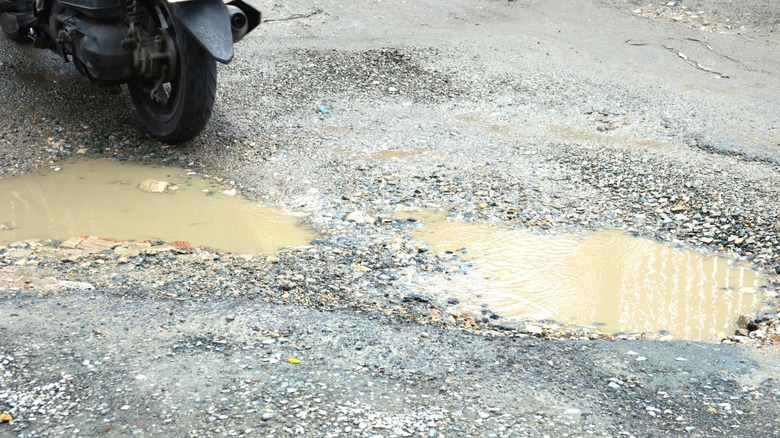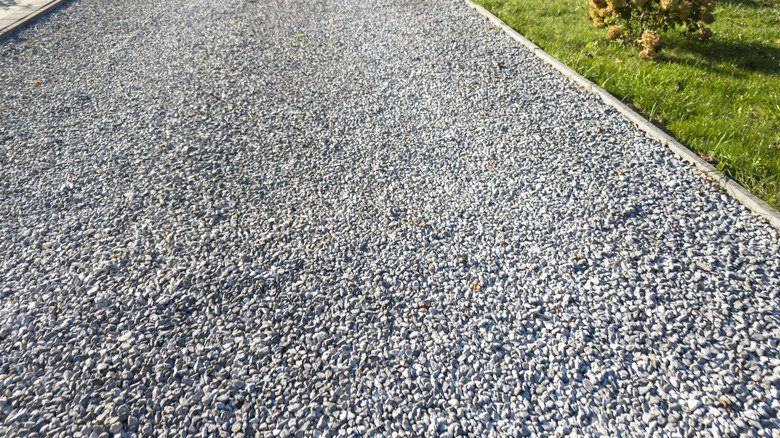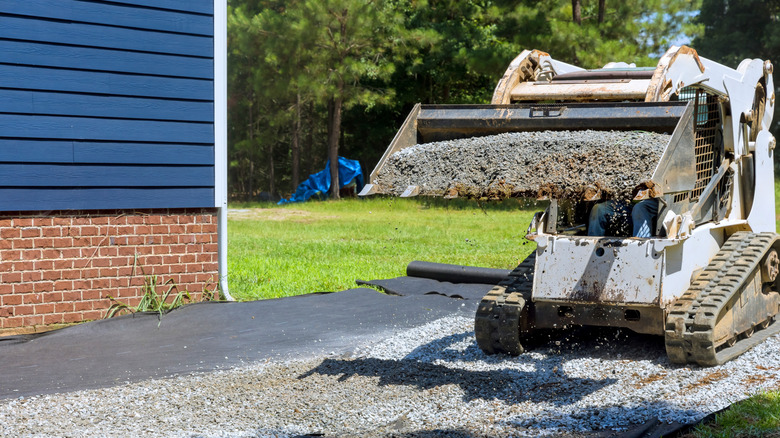A Clever Gravel Driveway Trick That'll Prevent Puddles And Improve Drainage
Stormwater can cause a lot of property damage. If your home isn't prepared to deal with an influx of water, you might end up with a flooded basement, cracks in the foundation, or erosion that could affect your lawn and driveway. There are driveway designs that take stormwater into account and make it easier for it to soak into the ground, from interlocking pavers to ribbon ("Hollywood") style driveways, but adapting a gravel driveway that collects water in spots can be difficult. However, just as there are the best types of gravel you can use for your driveway, there are also better ways to lay out your driveway to improve its drainage. For example, consider installing some sloping crowns.
Although gravel might seem like the ideal material for dealing with excess water because of its permeable gaps, the issue is that a lack of drainage means standing puddles of water will seep into the driveway's foundation, weakening the base in a way that could lead to cracks, potholes, or other structural failures with repeated use. The common trench construction is particularly prone to poor drainage, as it incorporates just a thin, flat layer of gravel with hardly excavated shoulders. Putting in a crown, a bump rising roughly ½ inch for every 2 feet of driveway width that runs down the driveway's center to create slopes for water runoff, is a surprisingly simple solution you can take into your own hands with enough time, a shovel, and a wheelbarrow for carrying raw materials.
Measuring and designing a crown for your gravel driveway
To begin installing crowns in your gravel driveway, you're going to need some measurements. Use a level to see whether your driveway is truly flat or already has a slight natural slope, and measure the width of the driveway to figure out its central point. Crowning will rapidly drain water to the driveway's edges to minimize erosion, and it requires sloping from dead center to the outer edges. As mentioned, your crown should go about 2 to 3 inches high for a standard gravel drive measuring 10 to 12 feet wide. There are two primary ways you can build out your gravel driveway crown, with the best option depending on how much work you want to put in upfront.
The somewhat easier method of creating a driveway crown is going to be pouring out a pile of ¾-inch gravel on that central line you measured and shaping it with a metal rake. This gravel driveway crown requires a refresh at least twice a year, in the spring and fall, to make sure it's still apt for driving. Alternatively, you can shovel off all of the gravel currently set on the driveway, and then cart over soil to create a crown in the underlying material. You're still going to even the surface out to create smooth slopes using your shovel and rake before replacing the gravel. Adding more gravel to an existing driveway won't always solve your problems, but altering the ground underneath is a potentially more permanent solution.
Picking the right tools for your gravel driveway maintenance
The best type of gravel to use for a driveway crown will be man-made crushed, as this lies flat and has edges that can lock together for smoother driving. This will also have better drainage to remove water that soaks through. Avoid options like smoother river-run gravel or larger cobble stones, because these will be less stable for driving. Smoother stones would also open more gaps for weeds to spread under and throughout the driveway. However, do note that gravel is one of the cheapest options available, which means it has a shorter lifespan and needs consistent maintenance. After some time, you may need heavier equipment than a rake to manage significant puddling and poor drainage, at which point you can rent a tractor or grader to make DIY repairs faster and easier.
If you are renting a tractor, try to find one with a handful of attachable parts, like box blades, land planes, and rear blades, to help you shape the crown and level the driveway as you redo your crown. Keep in mind that adding a crowned slope is a great start to fixing drainage problems, but it isn't going to work alone. Improperly designed shoulders will still allow water to seep into the driveway's foundation and undermine all that work. Shoulders should slope as much as, if not more than, the main driveway, ideally dumping runoff into ditches at least a foot deeper than your driveway's gravel base. Lean into these useful drainage solutions to prevent your yard from overflowing, and help your driveway survive frequent comings and goings for a longer time.


